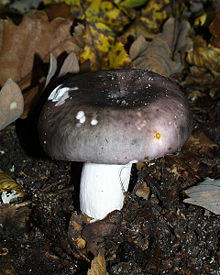| Russula cyanoxantha | |
|---|---|

| |
| Russula cyanoxantha | |
| Scientific classification | |
| Domain: | Eukaryota |
| Kingdom: | Fungi |
| Division: | Basidiomycota |
| Class: | Agaricomycetes |
| Order: | Russulales |
| Family: | Russulaceae |
| Genus: | Russula |
| Species: | R. cyanoxantha |
| Binomial name | |
| Russula cyanoxantha (Schaeff.) Fr. (1863) | |
| Synonyms | |
List
| |
| Russula cyanoxantha | |
|---|---|
| Gills on hymenium | |
| Cap is flat or convex | |
| Hymenium is adnate | |
| Stipe is bare | |
| Spore print is white | |
| Ecology is mycorrhizal | |
| Edibility is choice | |
Russula cyanoxantha, commonly known as the charcoal burner or variegated russula, is a basidiomycete mushroom. It can be confused for a number of other members of its genus. It is an edible mushroom.
Description
The most salient characteristic is the weak gills, which feel greasy to the touch, are flexible and do not break. The cap is 4–18 cm (1+1⁄2–7 in) wide, convex at first and later flattened, and greenish to bright brown; they vary considerably in color. The stipe is pure white, slightly convex underneath, from 2.5–12 cm (1–4+3⁄4 in) in height and 1–5 cm (1⁄2–2 in) in diameter. The white-to-cream gills are sometimes forked. The spores are white, as is the spore print. The stipe will give a green reaction when rubbed with iron salts (ferrous sulphate), while most other Russula species give a salmon reaction.
Similar species
It is distinguished from most other members of the genus by the fact that its gills do not split, but are soft and flexible.
The cap of the grey-green Russula grisea is more blue-grey but has violet or green hues with light cream gills; it also grows in mixed forests, particularly under beech, and more rarely in coniferous forests. Russula olivacea also may have a variegated cap, but produces yellow spores. Russula aerugineais is greenish and has forked gills. Russula variata is frequently forked and found in the east. R. versicolor has yellowish, unforked gills.
Habitat and distribution
Russula cyanoxantha grows in slightly acidic, but nutrient-rich soil. Like all Russulas, it is a mycorrhizal fungus. It is found most commonly in beech forests, and often in deciduous or mixed forests.
It is possible but not conclusive that R. cyanoxantha may only appear in Europe, while specimens identified elsewhere may be other species. It is one of the most common species of Russula in Europe.
It appears from July to October in both eastern North America and the Mountain states, and from October to January in western North America.
Uses
The edible mushroom is suitable for many kinds of preparation; the flesh is not as hard as that of many other edible Russulas. It has a mild, nutty taste.
It was designated "Mushroom of the Year" in 1997 by the German Association of Mycology.
See also
References
- Arora, David (1986). Mushrooms demystified: a comprehensive guide to the fleshy fungi (Second ed.). Berkeley: Ten Speed Press. ISBN 978-0-89815-169-5.
- ^ Davis, R. Michael; Sommer, Robert; Menge, John A. (2012). Field Guide to Mushrooms of Western North America. Berkeley: University of California Press. pp. 108–109. ISBN 978-0-520-95360-4. OCLC 797915861.
- ^ Audubon (2023). Mushrooms of North America. Knopf. p. 196. ISBN 978-0-593-31998-7.
- Phillips, Roger (2010) . Mushrooms and Other Fungi of North America. Buffalo, NY: Firefly Books. p. 137. ISBN 978-1-55407-651-2.
- E. Garnweidner. Mushrooms and Toadstools of Britain and Europe. Collins. 1994.
External links
 Data related to Russula cyanoxantha at Wikispecies
Data related to Russula cyanoxantha at Wikispecies Media related to Russula cyanoxantha at Wikimedia Commons
Media related to Russula cyanoxantha at Wikimedia Commons- Russulales News page on Russula cyanoxantha
| Taxon identifiers | |
|---|---|
| Russula cyanoxantha |
|
| Agaricus cyanoxanthus | |